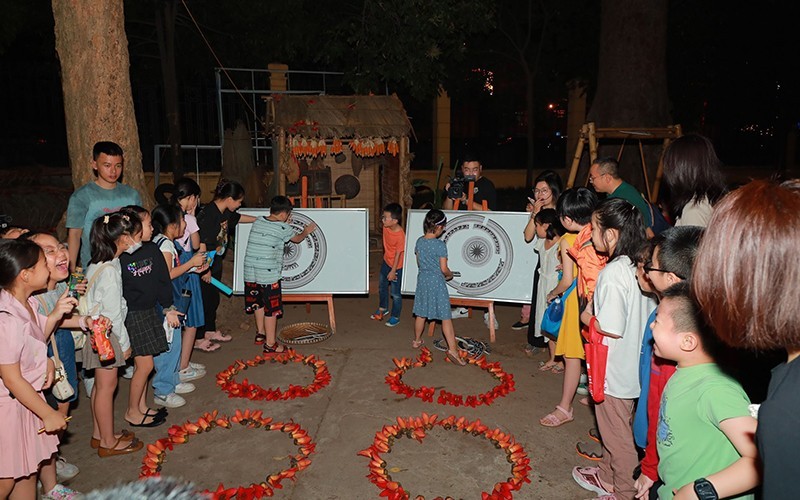With the aspiration to attract more and more visitors, especially young people, several museums and relic sites have made efforts to promote creativity to create products that help improve the experience of tourists. This is not only a direction to spread and promote the value of museums, relic sites and preserved artefacts, but also an effective way to generate revenue, to sustainably serve the conservation and maintenance activities of museums and relic sites.

Children are experiencing jigsaw puzzles of bronze drums when participating in the tour “Sounds of ancient bronzes”, at the Vietnam National Museum of History.
Recently, when coming to the Van Mieu-Quoc Tu Giam relic site, in Hanoi, young visitors can participate in the exciting journey of “finding mascots on ancient architecture”, that is designed in the form of games on an iPad.
The game consists of six doors equivalent to six architectural styles of the relic sites, including Four Pillars, the Gate of the Temple of Literature, Dai Trung Gate, Khue Van Cac, Dai Thanh Gate and Bai Duong House. At each door, if participants identify and choose the right answer about the meaning of the mascots on the architectural works, they will go to the next door. Meanwhile, if the answer is wrong, they must choose the answer again until it is correct.
The team that gets through all the doors in the fastest time wins. The “Finding mascots on ancient architecture” game is designed for four age groups, from four to 15 years old and from 16 years old and over, with levels ranging from easy to difficult. Interestingly, to participate in the game, players have to play on their iPads and move to architectural buildings to observe and identify new characters. The game has attracted many students to register for the experience so that they can not only identify the meaning of the mascots but also better understand the architectural works at relic sites.
Vietnam Fine Arts Museum has also focused on building the iMuseum VFA multimedia voiceover application. The app is integrated on both Android and iOS platforms, using QR codes or identifiers for works. More than a normal automatic voiceover application, iMuseum VFA has outstanding features such as allowing visitors to view high-quality images of the works, read the contents of the introductions, locate artefacts, see display system diagrams, and distinguish rooms by colour.
With only a mobile phone or tablet with an internet connection and a fee for an application download, visitors can freely explore 100 typical works on the regular display system of the Vietnam Fine Arts Museum, in both direct and online forms, with multiple language options of Vietnamese, English, French, Chinese, Japanese, Korean, Spanish, Italian and German.
Based on the iMuseum VFA system, the Vietnam Fine Arts Museum has been developing many themed tours such as "Vietnamese Lacquer Painting" or "National Treasure", to help visitors easily access and “chat” with museum artefacts in a new way.
According to Master Duong Ngoc Ha from the Centre for Cultural and Scientific Activities under Van Mieu-Quoc Tu Giam (Temple of Literature), the linkage between the displayed artefacts and the method of visiting and studying in the museum is undergoing a strong shift. It is a shift from being aware of a cultural experience as a form of information that a museum holds and transmits to visitors, to something that can be discussed and shared. A memorable experience is always a strong attraction because it gives visitors not only knowledge but also skills and emotions.
To bring diverse and impressive experiences, it is essential to mention the participation of technology. Director of the Hue Museum of Royal Antiquities Huynh Thi Anh Van said, in the context of the 4.0 revolution, the application of high technology to display and exhibit activities is one of the indispensable methods of advanced museums.
Especially, the trend of display and interpretation combined with interaction is now becoming a popular trend in the world. In particular, the architectural design that combines landscape and exhibition space has been carefully researched to express a unified and transparent message, bringing many emotions to viewers. New experiences for visitors can be enhanced with different forms of interpretation through interactive applications, or a combination of real artefacts and appropriate design images, thereby helping viewers feel the connection between personal perception and what they viewed.
It can be said that there is no shortage of technological solutions to increase interaction to help diversify visitors' experiences for museums and relic sites. However, according to experts, technology is only a means. It is important to have ideas, deep contents and resources to implement. Therefore, museums and monuments need to focus on developing the staff who love the profession, have a deep understanding of heritages and are rich in creativity, while making suitable ways to call for economic and technological resources to jointly create attractive interactive products.
Viet Anh - Translated by NDO